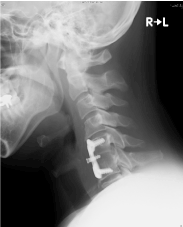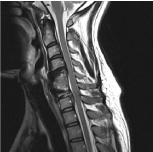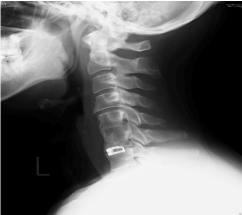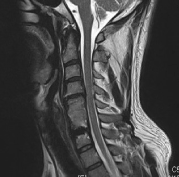A-42-year-old man presented with sudden anterior chest and upper back pain without radicular pain, sensory disturbance, or motor weakness, when elevated bilateral arm at the time of sleeping. The patient has a history of being performed C5-C6 ACDF (anterior cervical discectomy and fusion) 115 years ago. Because the severe pain continued, the patient was conveyed to the emergency room in our institution. Physical examination was unremarkable, when the patient arrived at our hospital. And no neurological deficit was recorded. The pain localized midline lesion of anterior chest and upper back and was increased with sitting position. Electrocardiogram, cardiac enzymes, chest X-rays and contrast-enhanced CT were performed, and the results were within normal limit. Myocardial infarction, ruptured aorta, pulmonary embolus, and pneumothorax were excluded. At second hospital day, we ordered MRI of cervical and thoracic spine. MRI revealed a large central extradural C6-C7 disc herniation, compressing the spinal cord, at which high signal intensity was observed in the spinal cord. We suspected the midline lesion of anterior chest and upper back pain occurred by cervical disc herniation, so operation was performed at tenth hospital day. After plate and screw at the previous surgery was removed, a fragment of the herniated disc was removed under microscope and C6-C7 ACDF with titanium cage containing iliac crest bone was performed. The pain disappeared almost completely within 24 hours after surgery. We were able to conclude that cervical discogenic pain was proved to be a responsibility lesion, because the symptom was improved immediately after C6-C7 ACDF.
Sudden anterior chest and upper back pain, Cervical disc herniation, Anterior cervical discectomy and fusion (ACDF)
Typically, cervical disc herniation presents unilateral or bilateral radicular pain with posterior neck and upper back pain. We experienced a case of cervical disc herniation presented with sudden midline lesion of anterior chest and upper back pain without radicular pain, sensory disturbance, or motor weakness. This is the first report that midline lesion of anterior chest pain and upper back pain is caused by cervical disc herniation, as far as we investigated.
A-42-year-old man presented with sudden anterior chest and upper back pain when he elevated bilateral arm at the time of sleeping. He did not suffer radicular pain, sensory disturbance, or motor weakness, because the severe pain continued, he was conveyed to the emergency room in our institution. He has no remarkable medical history other than urinary stone, but he has a history of being performed C5-C6 anterior cervical discectomy and fusion (ACDF) 15 years ago. His physical examination was unremarkable. Blood pressure is 161/108mmHg, Pulse is 79/min, SpO2 is 99%. Neurologic examination revealed hyper-reflexia of BTR, normal reflex of BrR, TTR, PTR, ATR and negative signs of Hoffman’s reflex. Motor function of the extremities (Grade 5/5) and sensory was normal. Only neck motion was limited slightly. The pain located midline of anterior chest and upper back and exacerbated at sitting position.
Laboratory findings were within normal limits, and no significant elevation was noted in cardiac enzymes including troponin.
Electrocardiogram, chest X-rays and contrast-enhanced CT were performed, and the results were within normal limit. Myocardial infarction, ruptured aorta, pulmonary embolus, and pneumothorax were excluded. Lateral radiograph of cervical spine showed post anterior cervical discectomy and fusion, and screw shifted backward (Figure 1).

Figure 1. Preoperative lateral X-ray of the cervical spine.
MRI revealed disc herniation at C6-C7 sequestrated to below C7 vertebral body (Figure 2), and no abnormal findings in thoracic spine. We suspected that cervical disc herniation was responsibility lesion of anterior chest and back pain.

Figure 2. Preoperative T2-weighted sagittal MRI demonstrating large disc herniation at C6-C7 level.
We performed bilateral C7 nerve root block, but the pain was reduced somewhat, he was enabled to sit for short time. We performed the operation that removed plate and screw at previous surgery and C6-C7 ACDF, removed fragment of the herniated disc under microscope (Figure 3). The pain disappeared almost completely after surgery immediately, and he was enabled to sit for a long time. MRI after surgery revealed no disc herniation (Figure 4).

Figure 3. Postoperative lateral X-ray (C6-7ACDF was performed).

Figure 4. Postoperative sagittal T2-weighted MRI at C6-C7 level (Large cervical disc herniation is not found).
One of the diseases with sudden upper back pain is SSEH at cervical or thoracic spine. The feature of SSEH is that develops for back pain corresponding with bleeding part, and progresses paralysis is recognized with progress of the time [1].
But there is 10 report of SSEH which develops only sudden back pain without neurological deficit [1,2]. In the case of a hematoma, sharp pain was reduced by a unit at time or might turn worse, but in our case the change over time of the pain did not accept.
Burak, et al. [3] reported that in 11(5%) of the 241patients who underwent C6-C7 ACDF, the primary complaint was unilateral chest pain, and that approximately 15% of patients with a C7 radiculopathy are likely to present with atypical symptoms.
Tanaka [4] performed prospective study of 50 patents of cervical disc herniation and reported 10 of 14 cases in C7 radiculopathy revealed scapular pain in one side. The anterior chest pain is a rare symptom as a cervical disk herniation [5], and in our case, the legion of anterior chest and upper back was midline, not partial in the one side.
Grubb, et al. [6] analysed retrospective data from C2-C3 to C7-T1 in 173 patients and found that C4-C5 to C6-C7 were responsible for the upper back pain. From base of neck extending into lower shoulder and shoulder blades, involvement of anterior neck, and arm pain has been reproduced during C6-C7 discography, and anterior chest pain is associated with a positive pain response only at C6-C7. But in this report, the location of pain was restricted midline lesion of anterior chest and upper back pain was none. In our case, we could not perform discography, because huge cervical disc herniation compressed spinal cord highly and we might bring about a new neurologic symptom by performing discography.
We were able to conclude that cervical discogenic pain was proved to be a responsibility lesion, because the symptom was improved immediately after C6-C7 ACDF. There are multiple sources for anterior chest combined with upper back pain. After the most lethal possibilities are ruled out, it makes sense to consider the cervical and thoracic spine as a source.
The authors declare that there are no conflicts of interest.
T. Tominaga wrote and prepared the manuscript, and all of the authors participated in the study design. All authors have read, reviewed, and approved the article.
- Groen RJM (2004) Non-operative treatment of spontaneous spinal epidural hematoma: A review of the literature and a comparison with operative cases. Acta Neuro-chir 146: 103-110. [Crossref]
- Serizawa Y, Ohshiro K, Tanaka K, Tamaki S, Matsuura K, et al. (1995) Spontaneous resolution of a spontaneous spinal epidural hematoma without neurological deficits. Intern Med 34: 992-994. [Crossref]
- Ozgur BM, Mashall LF (2003) Atypical presentation of C-7 radiculopathy. J Neurosurg 99: 169-171. [Crossref]
- Tanaka Y, Kokubun S, Sato T, Ozawa H (2006) Cervical roots as origin of pain in the neck or scapular pain. Spine 31: E568-573. [Crossref]
- Grgic V (2008) Cervicogenic angina. Chest pain caused by unrecognized disc herniation at the segment c6-c7: a case report. Lijec Vjesn 130: 234-236. [Crossref]
- Grubb SA, Kelly CK (2000) Cervical discography: clinical implications from 12 years of experiences. Spine 25: 1382-1389. [Crossref]




